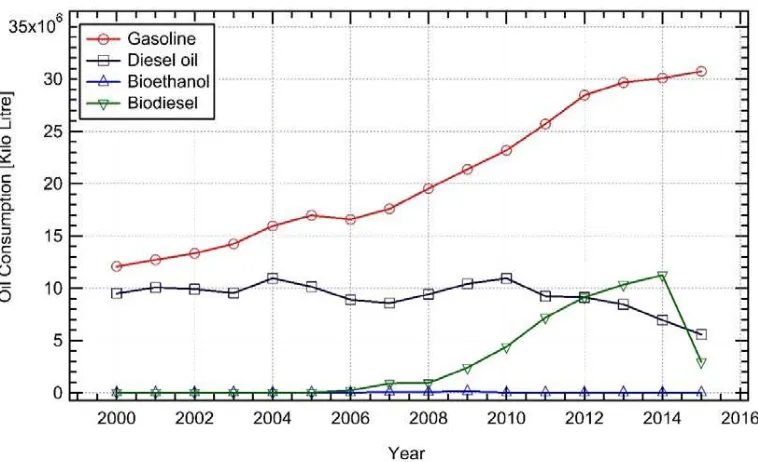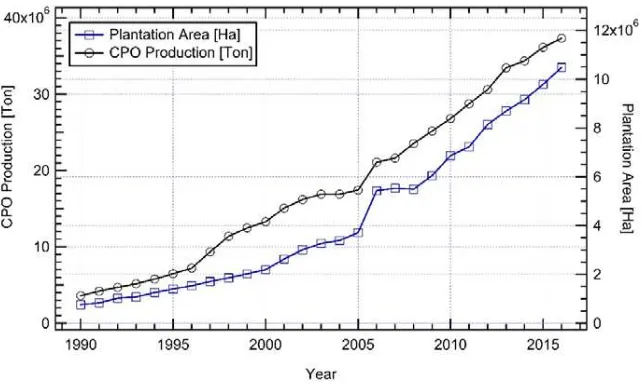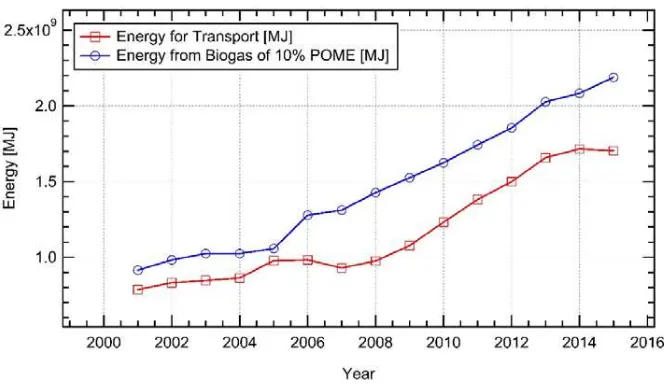PAPER • OPEN ACCESS
Internal combustion engine run on biogas is a
potential solution to meet Indonesia emission
target
To cite this article: Himsar Ambarita 2017 IOP Conf. Ser.: Mater. Sci. Eng.237 012013
View the article online for updates and enhancements.
Related content
A Pedagogical Introduction to Electroweak Baryogenesis: The Sakharov conditions
G A White
-A Pedagogical Introduction to Electroweak Baryogenesis: Other mechanisms for producing the baryon asymmetry
G A White
-Adaptive system of supplying lubricant to the internal combustion engine
E P Barylnikova, A T Kulakov and O A Kulakov
-1
Content from this work may be used under the terms of theCreative Commons Attribution 3.0 licence. Any further distribution of this work must maintain attribution to the author(s) and the title of the work, journal citation and DOI.
Published under licence by IOP Publishing Ltd
Internal combustion engine run on biogas is a potential solution to meet
Indonesia emission target
Himsar Ambarita
1Sustainable Energy and Biomaterial Centre of Excellent, Faculty of Engineering,
University of Sumatera Utara, Jl. Almamater Kampus USU Medan 20155, Indonesia
Abstract. Indonesia has released two different Greenhouse Gas (GHG) emissions reduction targets. The first target, released in 2009, is reduction GHG emissions 26% from Business-as-Usual (BAU) level using own budget and up 41% if supported international aids by 2020. The second target is reduction 29% and 41% from BAU by 2030 using own budget and with international support, respectively. In this paper, the BAU emissions and emissions reduction target of these two targets are elaborated. In addition, the characteristics of emissions from transportation sector are discussed. One of the potential mitigation actions is switching fuel in transportation sector. The results the most promising mitigation action in the transportation is switching oil fuel with biofuel. The Government of Indonesia (GoI) focuses on using biodiesel and bioethanol to run internal combustion engine in transportation sector and biogas is aimed to fuel power plant unit. However, there is very limited of success stories on using biogas in the power plant. The barriers and challenges will be discussed here. It is suggested to run internal combustion engine with biogas.
1. Introduction
Global warming or climate change is the rise of the average temperature of the earth’s climate system. The global warming is caused by GHG emission from all activities in the world. To avoid the catastrophe, mostcountries coordinated by United Nations Framework Convention (UNFCC), have committed on reducing their GHG emissions. Parties of UNFCC have agreed that deep cuts in emissions are required and that global warming should be limited to well below 2.0oC compared to pre-industrial levels. The Government of Indonesia (GoI) has
released two targets in the last 10 years. The first target is released in 2009. Here, GoI has committed on reduction GHG emissions 26% from Business-as-Usual (BAU) level using its own budget and up 41% if supported international aids by 2020 [1]. The second target is released in 2016. The emission reduction is 29% and 41% from BAU by 2030 using own budget and with international support, respectively [2].According to Intergovernmental Panel on Climate Change (IPCC), the GHG emissions can be divided into four sectors. They are Energy, Industrial Process and Product Use (IPPU), Agriculture, Forestry, and other Land Use, and Waste sectors [3]. Since the targets have been released, the main issue in Indonesian development includes emission reductions or mitigation actions. Several studies on mitigation actions to meet Indonesia target have been found in literature.
renewable energy come on line. In order to boost investment on renewable energy development, the government control over the oil industry should be reduced. Clarifying and simplifying regulations is keys to attracting foreign companies and protecting the environment. Jafari et al [5] examined the long run Granger causality relationship between economic growth, carbon dioxide emissions and energy consumption from 1971 to 2007 in Indonesia. It was found that there was no relationship between these parameters except the causality effect that runs from urban population to energy consumption. The finding suggested that energy conservation strategies in Indonesia may not procedure desirable effect on emission target and Indonesia does not have to relinquish economic growth. Alam et al [6] examined the impacts of income, energy consumption and population growth on GHG emissions by using a yearly time series data from 1970 to 2012 of India, Indonesia, China, and Brazil. The results revealed that GHG emissions have increased significantly with increase in income and energy consumption. In addition, population growth has been statistically insignificant for Indonesia and GHG emissions will decrease over time when income increase. It was suggested that Indonesia should not develop any mitigation actions or its policy that might have conservative impacts on income. Mujiyanto and Tiess [7] reported the study on secure energy supply in 2025 of Indonesia energy policy. The results showed that investment incentive for new technologies, exploration and efficient production are necessary. It was suggested to provide clear and comprehensive energy policy strategy and regulatory framework. Deendarlianto [8] presented energy mix model for transportation sector in Indonesia. Several strategies have been examined such as introduction compressed natural gas (CNG) technology, vehicle retirement program, and hybrid vehicles. The results revealed that the most effective strategy in mitigation action is retirement program of old vehicles. On the other hand, the CNG program does not give significant impact on emission reduction, subsidy cost and fuel consumption. Sukarno et al [9] investigated the effects of household lifestyle on residential energy consumption. The study showed that power consumption (operation and standby mode), number of appliances and operating hours are the three aspects that play an important role on decreasing GHG emission.
The above reviewed studies reveled that study on the Indonesian mitigation actions, especially in energy sector, has come under scrutiny in recent years. However, the study on effect of fuel switching strategy on the emission reduction target has not found yet. In this study, the potency of employing biogas to run internal combustion engine will be examined. The main objective is to supply the necessary information for GoI to meet the emission reduction target.
2. Methods
This study is a combination of literature review and analysis. The policy released by the GoI relate to GHG emissions are reviewed. The history of energy consumption by using statistic data is presented and based on the history, energy consumption is projected to develop BAU emission. The potency of biogas from selected sector is examined. Several research papers on combustion engine fueled by biogas are reviewed to draw fossil fuel replacement ratio.
3. Results and Discussions
3.1. Policy and Energy Consumption
3
National Development Plan (RPJP) and Mid-term National Development Plan (RPJM) in 2007. This is known as a starting for Indonesian commitment on low emission development. Since then, many regulations to support the commitment have been released as shown in the figure. There are three significant milestones that received many attentions in national and international levels. The first regulation is President Regulation No 61 Year 2011 on National Action Plan on reduction GHG emissions (RAN-GRK). In this regulation, GoI has designed several mitigations action that must be implemented in national level to reach Indonesia emission targets. In the regulation, it is emphasized that local government should develop the similar regulation to support the RAN-GRK. Thus, in 2012 there are 33 government regulation in provincial levels have been released. The second significant regulation is President Regulation No 71 Year 2011 regarding on GHG inventory. The third regulation is President Regulation No 22 Year 2017 on National Energy Planning. In this regulation, a planning to meet energy consumption in Indonesia until 2050 has been formulated. In addition, actions to meet the new emission target 29% from BAU by 2030 have been formulated.
Figure 1. Milestone Indonesian Policies related to GHG emission
Table 1 Emission target in two Indonesian targets
Sector
Emission Reduction Target in Million Ton (MT) CO2eq
By 2020 By 2030
26% 41% 29% 41%
Forest and Pet Land 672 1039 - -
Agriculture 8 11 - -
Energy and Transport 36 56 - -
Industry 1 5 - -
Waste 48 78 - -
TOTAL 767 1,189 848 1,191
In Indonesia, the energy consumption typically divided into several subsectors, they are household, industrial, transportation, commercial and others. In2015, the total energy consumption in Indonesia was 1,040,677,025 Barrel Oil Equivalent (BOE). The final energy consumption and energy share in Indonesia in 2015 are shown in Figure 2. The figure shows that transportation sector is the biggest consumer with percentage of 36% of this energy and followed by Industrial and Household sectors with percentage of 31% and 15%, respectively.
Figure 2. Final energy consumption and energy share in 2015
The analysis reveals that the intensity of energy per capita in Indonesia in 2015 was 2.86 BOE/capita. The energy consumption per capita in the last 5 years from 2011 to 2015 are 3.5, 3.55, 3.18, 3.19, and 2.86 BOE/capita, respectively. These number shows that the energy consumption decrease with increasing time. This is might be because the increasing in energy price and energy conservation and energy efficiency programs. The energy share of the final energy consumption is also shown in the figure. The figure shows that 46% of energy consumption comes from oil and followed by coal and gas with share of 26% and 23%.
5
Table 2 New and Renewable Resources New and Renewable
Coal Bed Methane 456.7 TSCF Note: TSCF: Trillions of standard cubic feet
Figure 3 shows the BAU projection of energy consumption and the alternative projections. The alternative projection is defined as energy consumption if all of mitigation actions and utilization of renewable energy resources are implemented. In the figure, the BAU energy consumption is made based on the assumption that the growth of Gross Domestic Products (GDP) of Indonesia is 5.6% yearly during 2016 -2050.The population growth is 1.19% in 2015, 1.00% in 2020, 0.8% in 2025, and 0.62% from 2030 to 2050. In 2015 the population is 255 million and it will be 335 million in 2050. During 2016 to 2050, it is assumed that fuel price increases as 1.2%, 0.9%, 2.3% per year for coal, natural gas, and oil, respectively. In the projection of alternative 1 (Alt 1), the same assumptions in BAU are used but, all mitigation actions and renew able energy programs are implemented perfectly. The share energy in 2015 is 5%, the projection of renewable energy share in 2025, 2030, and 2050 are 22%, 26%, and 31%, respectively. The penetration of the present proven technologies is assumed to be 75%. In the alternative 2, all of the assumption in alternative 1 are employed. But, the difference is the GDP growth. In alternative 2, the GDP growth is assumed to be 7.1% yearly.
By using the above assumptions, the BAU scenario reveals that the final energy consumption will grow from 128.8 million tons oil equivalent (MTOE) in 2015 to 238.8 MTOE in 2025 and 682.3 TOE in 2050. In the same way, the GHG emissions will grow from 484 MTCO2eq in year 2015 to 948 MTCO2eq in year 2025 and 2,886 MTCO2eq in year 2050.
These values show that the final energy consumption and GHG emission growing 85% and 95%, respectively in year 2025 in comparison with the energy consumption and emission in year 2015. On the other than in year 2050 the growth of energy consumption and emission are 430% and 496%, respectively. If all of the technologies are implemented, the final energy consumption in 2025 and 2050 are 201.5 MTOE and 430.3 MTOE, respectively. In the same way, the emission will grow to 687 MTCO2eq in year 2025 and to 1,360 MTCO2eq in year
2050. On the other hand, in the Alt2 scenario the final energy consumption in 2025 and 2050 are 244 MTOE and 621 MTOE, respectively. In this scenario, the emission will grow to 888 MTCO2eqand 1,928 MTCO2eq in year 2025 and 2050, respectively.By using the alternative 1,
the emission reduction that can be reached in 2020 and 2030 are 11% and 33%, respectively. These values, shows that the target of emission reduction can be reached in energy sector by implementing the alternative perfectly.
3.2. Combustion Engine run on Biogas
The main challenge in the implementation of alternative 1 is in the transportation subsector. This subsector is the main energy consumer in the energy sector. The transportation sector includes all of vehicles for public use and for agricultural use. In this subsector, the proposed mitigation actions mainly consist of penetration of technologies efficient combustion engine, hybrid cars, electric cars and fuel switching. The fuel switching program is supported by Indonesian Ministry of Energy and Mineral Resources regulation no 25 year 2013 on the revision of regulation no 32 year 2008 concerning the provision, utilization and commerce of biofuel as alternative fuels. The target of fuel switching in gasoline and diesel oils has shown in Table 3.
Table 3 Mandatory biofuel content for subsidized public service obligation fuels
Fuel 2013 2014 2015 2016 2020 2025
Mandatory Gasoline mixture
bioethanol content 0% 0.5% 1% 2% 5% 20%
Mandatory Diesel fuel mixture
7
Figure 4. History fuel consumption in transportation sector in Indonesia
The effect of that regulation can be seen in the national oil consumption as shown in Figure 4. The figure shows the gasoline, diesel oil, bioethanol and biodiesel consumption in Indonesia from 2000 to 2015. The figure shows that, in the transportation subsector the consumption of fuel increase with increasing time. There is a strong effect of oil price to fuel consumption. The effect of mandatory biofuel regulation can be seen clearly in the figure. However, only biodiesel shows the significant growth. In several years, it can be over than diesel fuel. This is because Indonesia has abundant biodiesel resources from Palm Oil industry. On the other hand, the growth of bioethanol is very low. The highest bioethanol consumption was 126,048 Kilo liter in 2006 and after that it is zero. Even though, according to regulation the mandatory bioethanol consumption in 2016 must be up to 2%, however, the statistics data show that the bioethanol consumption in 2016 is zero.
modified CI engine cannot be easily converted into pure diesel mode. The study by Ambarita [11] showed that for a small CI engine run on dual-fuel mode, the diesel oil replacement ratio varies from 15.3 % to 87.5%. This means, this technology is potential to reduce diel oil consumption as well as GHG emission.
Figure 5. History of Plantation Area and CPO production of Indonesia
As mentioned above, the potential biofuel for fuel switching application is biogas. The biogas is an important source of biofuel produced from anaerobic biodegradation of organic material. It consists of methane typically range from 40 - 70% and its low heating value is between 15 and 30 MJ/Nm3. Indonesia, as an agricultural country, has an enormous potency
of biogas. One of the potential biogas resources in Indonesia is Palm Oil Mill Effluent (POME). The traditional treatment of POME is by collecting it in a pool. After a certain time, it will release methane gas into atmosphere. As a note, methane gas is also a greenhouse gas that results in climate change. According to IPCC, methane gas 21 time more dangers than CO2. An analysis shows that 70% of GHG emissions from Crude Palm Oil (CPO) production
process resulted by traditional POME production. Thus, strategy to capture POME and use it as fuel to replace oil for transportation and machineries has multiple effects on GHG emission reduction. This is because, it will reduce methane and CO2 both from as GHGs. Indonesia is
9
Figure 6. Energy for Transportation and Biogas from POME
Harsono et al [14] reported a study on the anaerobic treatment of POME to produce biogas as an energy source and to avoid GHG emissions. The study and data collections were carry out in a Palm Oil industry at a Palm Oil company PT Asam Jawa in Sumatera Utara province of Indonesia. The industry has plantation area of 130,000 Ha. The results revealed that total energy input and energy output of POME treatments are 84 MJ/ha/year and 2021 MJ/ha/year, respectively. The net energy yield is 1937 MJ/ha/year. Since the Palm Oil industry in Indonesia is well developed, this energy yield can be used to predict energy produced from converting POME into biogas. If only 10% of the energy produced in Biogas can be used in transportation sector, the energy produced from biogas and energy used for transportation are presented in Figure 6. The figure shows that it is possible to employ the biogas energy to replace oil consumption in transportation sector.
4. Conclusions
In this work, regulations related to climate changes in Indonesia have been reviewed. The strategies to meet the emission targets have been elaborated. The conclusions can be drawn here are as follows. The GoI has shown strong commitment on reducing its GHG emissions. Several regulations have been released to support the commitment. In the energy sector, there are two types of strategies are employed. Technologies intervention of energy efficient and switching to renewable energy resources. It was shown that Indonesia has a very big potency of new and renewable energy resources. However, in the condition of 2015, the utilized renewable energy resource is only about 5%. The GoI has a plan to increase its present energy share 5% in 2015 to 22%, 26%, and 31% in year 2025, 2030, and 2050, respectively. In order to meet these targets, biodiesel and bioethanol mandatory targets are introduced. However, the target especially bioethanol, seem to be failed. Thus, it is suggested to employ Biogas resulted from POME to be biofuel for transportation sector.
Acknowledgments
References
[1] Gov. of Indonesia Presidential Decree No No 61 Year 2011, National Action Plan For Reducing Greenhouse Gas Emissions.
[2] Gov. of Indonesia, 2016, First Nationally Determined Contribution Republic of
Indonesia.
[3] IPCC, 2006, Guidelines for National Greenhouse Gas Inventories. [4] R. Dutu, 2016 Energy Policy98, 513-519
[5] Y. Jafari, J. Othman, AHS Mohd Nor, 2012 Journal of Policy Modeling34, 879-889
[6] Md. M. Alam, Md. W. Murad, AH Md. Noman, I. Ozturk, 2016 Ecological
Indicators70, 466-479
[7] S. Mujiyanto, G. Tiess, 2013 Energy Policy61, 31-41
[8] Deendarlianto, A. Widyaparaga, BM. Sopha, A. Budiman, I. Muthohar, IC. Setiawan,
A. Lindasista, J. Soemardjito, K. Oka, 2017 Renewable and Sustainable Energy Reviews70, 12-23
[9] I. Sukarno, H. Matsumoto, L. Susanti, 2017 Urban Climate20, 20-32 [10] National Energy Council of Indonesia, 2016 Outlook Energy Indonesia [11] H. Ambarita, 2017 Case Studies in Thermal Engineering10, 179 - 191
[12] H. Ambarita, E.P. Sinulingga, M. KM. Nasution, H. Kawai, 2017 IOP Conference
Series: Materials Science and Engineering180, 012025.
[13] H. Ambarita, TI. Widodo, DM. Nasution, 2017 Journal of Physics: Conference
Series801, 012095
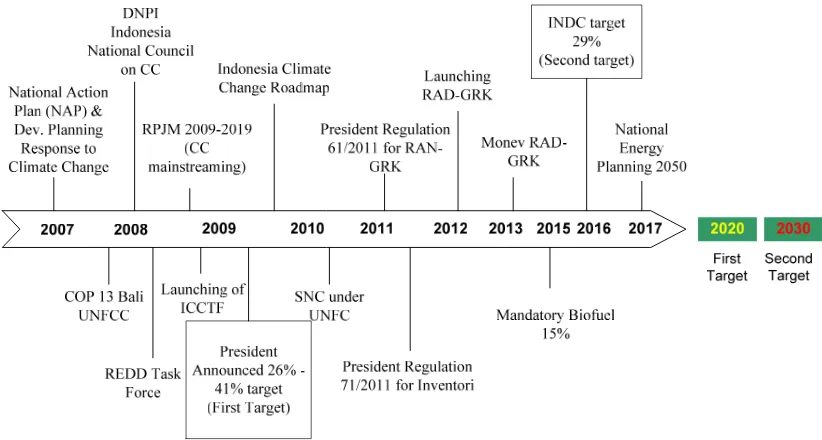
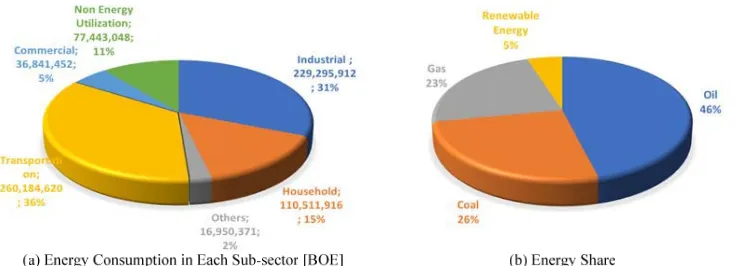
![Figure 3. Projection of final energy consumption and alternative projections [10]](https://thumb-ap.123doks.com/thumbv2/123dok/3908592.1860462/6.595.137.462.532.709/figure-projection-final-energy-consumption-alternative-projections.webp)

